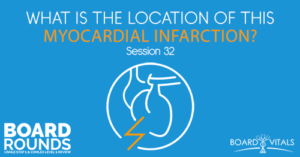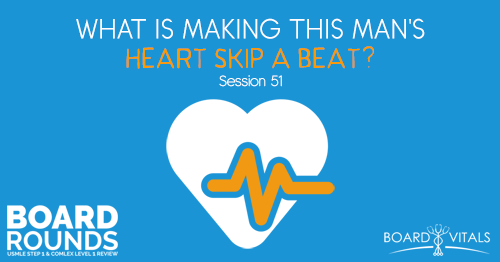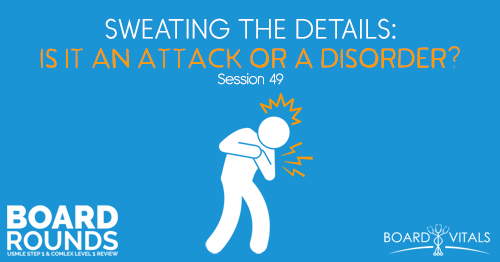Apple Podcasts | Google Podcasts

Session 32
Crushing substernal chest pain, bradycardia, elevated troponin, and decompensating. What are the subjective and objective signs of myocardial infarction?
Dr. Mike Natter from BoardVitals joins us today. He has an amazing artwork on Instagram where he depicts his journey through residency and beyond. We talk a lot about that today before we jump into our topic of the day. Follow Mike on Instagram @mike.natter.
[01:45] A Little Background About Mike
Mike is a third-year internal medicine resident at a New York City hospital. He initially went to an art school. Although he has always been interested in medicine because of his childhood diagnosis of Type I diabetes, he was scared of the sciences as it wasn’t a field he excelled in. So he had to put it on the backburner.
Specifically, he wanted to be an endocrinologist to help other people with diabetes. So he went to do a postbac in New York City which he found extremely challenging.
[01:45] A Little Background About Mike
Mike is a third-year internal medicine resident at a New York City hospital. He initially went to an art school. Although he has always been interested in medicine because of his childhood diagnosis of Type I diabetes, he was scared of the sciences as it wasn’t a field he excelled in. So he had to put it on the backburner.
Specifically, he wanted to be an endocrinologist to help other people with diabetes. So he went to do a postbac in New York City which he found extremely challenging. And he made his way to one medical school in Philadelphia where he was extremely happy with.
What he liked about the medical school he went to was how it was very supportive of his creative tendencies. He found himself drawing to help him learn medicine and which helped him excel in medicine. He also used his drawings as a tool to help his peers and patients learn, which he continues to do now in residency.
[04:27] Question of the Week:
A 60-year-old African-American female presents to the emergency medicine for an evaluation of crushing substernal chest pain. It radiates to her jaw. She has diaphoresis and nausea. Her heart rate is 50 beats per minute (bpm). Blood pressure is 130/80. Her troponin is 5.2. Her electrocardiogram is shown below. Morphin isosorbide dinitrate, lisinopril, aspirin, and heparin are all administered.
Thirty minutes later, the patient complains of increased shortness of breath and dizziness. Her pulse is 55/min. It’s regular. Her blood pressure is 90/60. Cardiac aspaltation is unremarkable. Her extremities are cold and clammy. Which of the following is the most likely cause of this patient’s decompensation?
(A) Ventricular wall rupture
(B) Papillary muscle rupture
(C) Fibrinous inflammation
(D) Reduced preload
(E) Aortic dissection
[05:28] Dissecting the Answer Choices
We can assume classic signs of myocardial infarction (MI). You shouldn’t have troponin in the blood. It should be inside the cells. So we know something is going on here. Then they give tons of medication.
The pulse is 55/min and the blood pressure is 90/60 so we can rule out answer choice A. The papillary muscle rupture would lead to auscultation so B is out.
Fibrinous inflammation doesn’t sound like it’s going to happen after 30 minutes so answer choice C is ruled out as well. With this condition, you’re going to expect to see days to weeks to months out, not necessarily acutely.
With aortic dissection, think of a tearing pain. The pain is not going to be the substernal chest pain so answer choice E is ruled out. Also, very often, the pain is going to radiate to your back.
Physiologically, the blood coming out of the left ventricle is going to have a very big disruption going through the aorta. So you’d usually see a large asymmetric pulse pressure and blood pressure. So one arm may be lower or higher than the opposite arm.
[09:50] Thought Process Behind the Correct Answer
This leaves us with answer choice D as the correct answer. Preload is how much blood is in the ventricle before contraction. If you look at this case clinically, women may not necessarily present with an MI in the same way that you’d suspect a “textbook” man would.
But in this particular vignette, it seems she’s coming in with substernal, crushing chest pain. She raised her jaw and she’s sweating and nauseous. These are classical signs of an MI or heart attack. The question hands us that on a silver platter. Troponin in the blood is never normal as it lives inside the myocardial cells. Unless there is some damage to those cells. That stuff should not ooze out into the blood.
So we already know she has damage to her heart. It’s happening acutely and she’s symptomatic from it. Interestingly, her heart rate of 50 bpm is normal-ish. It’s a little bit bradycardic or slower than what you’d expect.
For someone with a heart attack, you’d expect their heart rate to be much higher. This gives us a clue as to where is the damage in the heart and which vessels are being affected.
[11:53] Discussing Pieces of Evidence
We have objective evidence that she’s having a heart attack with her troponins. If we could see the EKG, it likely changes. But now we’re also getting some anatomic evidence of where this heart attack might be taking place.
When a heart attack affects a vessel that’s going to mess with the SA node. You can expect that there might be some issues in terms of your rate and rhythm. In this case, if she’s a bit bradycardic, one of the vessels that’s supplying the node is the culprit.
When that happens, you are going to be severely preload-dependent. If someone won’t beat fast or strong enough, the fluid you’re going to load up the heart with needs to be sufficient so you can perfuse the rest of your body.
The EKG is the map of the coronaries based on where the electrical activity is changed. So the exam would most likely give you a classic finding. Usually, a good diagram that’s worth memorizing here would be the coronaries and the correlated lead on the EKG.
[14:18] Additional Notes
The papillary muscle rupture is what’s holding on to the leaflets of the valves. So there were no auscultatory findings. You can’t hear any murmurs or anything else. If you had a papillary muscle rupture, you’d definitely be hearing this leaflet flaring around and smacking on things.
If it were ventricular wall rupture and aortic dissection, this person would deteriorate and would probably have zero pulse. There’s not enough blood to be pumped around in that case as there’d be no forward flow with no ventricular wall.
There would be no preload or no blood to push around with aortic dissection. The blood would be going to either false lumen rupture and bleeding now.
[15:55] BoardVitals
Check out their up-to-date, intense QBanks to help you with what you need to know for your board exam. Save 15% off their QBanks by using the promo code BOARDROUNDS.
Links:
BoardVitals (Save 15% off their QBanks by using the promo code BOARDROUNDS.)
Follow Mike on Instagram @mike.natter.
SEARCH SITE
LISTEN FOR FREE











